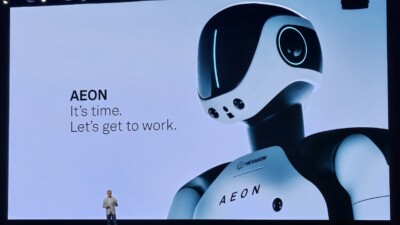Transform industrial data from disconnected and fragmented to a more unified, actionable strategic resource.
Artificial Intelligence (AI) is driving profound change across the industrial sector; its true value lies in overcoming the challenge of transforming fragmented, siloed data into actionable insights. As AI technologies reshape industries, they offer powerful capabilities to predict outcomes, optimize processes, and enhance decision-making. However, the real potential of AI is unlocked when it is applied to the complex task of integrating unstructured, “freshly harvested” data from both IT and OT systems into a cohesive, strategic resource.
This article explores the strategic application of AI within industrial environments, where the convergence of IT and OT systems plays a critical role. From predictive maintenance to real-time process optimization, AI brings new opportunities to unify disparate data sources through intelligent digital thread—driving smarter decisions that lead to both immediate operational improvements and long-term innovation. Insights are drawn from industry frameworks to illustrate how businesses can effectively leverage AI to transform data into a competitive advantage.
From raw data to ready insights
In an ideal world, industrial data flows seamlessly through systems and is immediately ready for AI algorithms to digest and act upon. Yet, the reality is far different at this stage. Much of the data that businesses generate is fragmented, siloed, unstructured, sometimes untimely available, making it difficult to extract real-time actionable insights. To realize the full potential of AI, organizations must confront this data challenge head-on.
The first hurdle is understanding the true nature of “freshly harvested” data—the new, often unrefined information generated through sensors, machines, and human input. This raw data is often incomplete, noisy, or inconsistent, making it unreliable for decision-making. The key question is: How can organizations transform this raw data into structured, meaningful insights that AI systems can leverage to drive innovation?
The role of industrial-grade data solutions
According to industrial thought leaders, the solution lies in the deployment of “industrial-grade” AI solutions that can manage the complexities of industrial data. These solutions must be tailored to meet the specific requirements of industrial environments, where data quality and consistency are non-negotiable. Seamless enterprise-wide data integration is key—whether for predictive maintenance that connects sensor data with enterprise asset management, real-time process optimization that synchronizes factory operations with ERP and MRP platforms—driving supply chain resilience that links production planning with logistics and inventory.
The first step in this process is data integration—the practice of bringing together disparate data sources into a unified ecosystem. This is where many organizations fail, as they continue to operate in data silos, making it nearly impossible to get a holistic view of operations. By leveraging industrial-grade data fabrics, companies can create a single, cohesive data environment where data from multiple sources, whether from edge devices or cloud systems, can be processed together in real time.
Data structuring—the secret to actionable insights
Once raw data is integrated, it must be structured in a way that makes it interpretable and useful for AI models. Raw data points need to be cleaned, categorized, and tagged with relevant metadata to create a foundation for analysis. This is a critical step in the data preparation lifecycle and requires both human expertise and sophisticated algorithms.
The structuring of data enables the development of reliable AI models. These models are trained on historical data, but the real power lies in their ability to make predictions and provide insights from new, incoming data—what we might call “freshly harvested” data. For example, predictive maintenance models can alert manufacturers to potential equipment failures before they occur, while quality control models can detect deviations in production in real time, allowing for immediate intervention.
The importance of explainability cannot be understated. For industrial AI applications to be truly valuable, stakeholders must be able to trust the insights generated. Clear, transparent AI models that are explainable ensure that human operators can understand and act upon AI recommendations with confidence.
Operationalizing AI for real results
Having structured data and trained models is only part of the equation. The real test is turning AI-generated insights into actionable outcomes. This is where real-time decision-making comes into play.
Organizations need to operationalize AI by embedding it within their decision-making frameworks. Real-time AI systems need to communicate directly with production systems, supply chains, and maintenance teams to drive immediate action. For example, an AI system might detect an anomaly in production quality and automatically adjust parameters, triggering alerts to the relevant personnel. The ability to act on AI insights immediately is what separates a theoretical AI application from one that delivers real-world value.
Moreover, feedback loops are essential. The AI models should not be static but should continuously learn and adapt based on new data and operational changes. This iterative approach ensures that AI doesn’t just solve problems for today but continues to improve and optimize processes over time.
Generative AI: A catalyst for innovation and workforce augmentation
While AI’s predictive capabilities are often the focal point, generative AI holds particular promise for transforming industrial workflows. By augmenting human creativity and problem-solving, generative AI helps address the skill gap in the workforce. For example, AI-assisted design can produce innovative solutions that human engineers may not have considered.
However, the integration of generative AI into industrial settings requires careful consideration. As powerful as it is, generative AI can be more costly than traditional AI models. Its inclusion in industrial applications must be strategic, ensuring that the value it brings—such as faster prototyping or more efficient design—justifies the investment.
How to build a sustainable AI strategy for data insights
Turning fragmented data into actionable insights requires a strategic approach. Based on industry frameworks from ABB and ARC Advisory Group, here’s a blueprint for effective AI adoption in industrial settings:
- Begin by understanding what is to be achieved through AI—whether it is optimizing efficiency, reducing downtime, or improving quality control. Align AI initiatives with these objectives to ensure focused efforts.
- Assess the existing data infrastructure and invest in solutions that integrate and standardize data across your systems. A unified data environment is crucial for enabling AI-driven insights.
- Avoid generic AI solutions. Instead, select AI tools that address specific use cases—whether it is predictive maintenance or process optimization. Tailored solutions are far more likely to provide valuable, actionable insights.
- In highly regulated industries, transparent and explainable AI models are essential for building trust and compliance. Make sure AI systems provide insights that are understandable and auditable.
- AI adoption is not a one-time implementation. Begin with pilot projects, learn from the results, and scale up gradually. This approach allows businesses to optimize AI systems while minimizing risk.
Scaling AI for broader impact
Collaboration is key to successful AI adoption. Partnering with experienced software providers, AI developers, and industry experts can help organizations navigate the challenges of scaling AI across their operations. Moreover, integrating generative AI alongside traditional AI approaches allows companies to strike a balance between innovation and cost-effectiveness.
The promise of AI in transforming industries is undeniable, but to truly realize its value, organizations must overcome the data fragmentation challenges that hinder effective AI deployment. By integrating, structuring, and operationalizing data, companies can convert raw information into actionable insights that drive measurable results. The future of industrial AI is not just about predictions and optimization—it’s about continuous learning, innovation, and the strategic use of AI to create sustainable, long-term growth.




